The global demining tool kits market is expected to reach USD 1,328.7 million by 2035, recording an absolute increase of USD 741.0 million over the forecast period. The market is valued at USD 587.7 million in 2025 and is set to rise at a CAGR of 8.5% during the assessment period. The overall market size is expected to grow by nearly 2.3 times during the same period, supported by increasing global security concerns worldwide, driving demand for efficient mine detection and clearance systems and rising investments in military modernization and humanitarian demining projects globally. However, high initial investment costs and complex training requirements for advanced demining systems may pose challenges to market expansion.
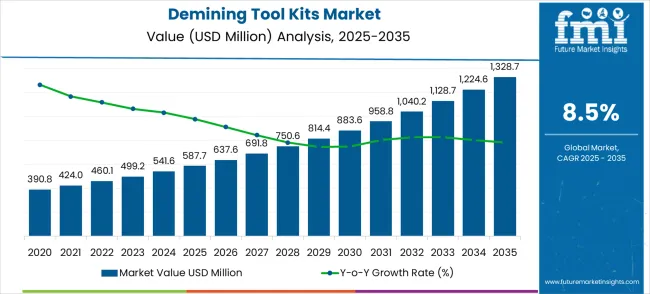
| Metric | Value |
|---|---|
| Market Value (2025) | USD 587.7 million |
| Market Forecast Value (2035) | USD 1,328.7 million |
| Forecast CAGR (2025-2035) | 8.5% |
Between 2025 and 2030, the demining tool kits market is projected to expand from USD 587.7 million to USD 883.6 million, resulting in a value increase of USD 295.9 million, which represents 39.9% of the total forecast growth for the decade. This phase of development will be shaped by rising demand for military and security solutions, product innovation in detection technologies and automated clearance systems, as well as expanding integration with smart surveillance and artificial intelligence initiatives. Companies are establishing competitive positions through investment in advanced detection technologies, precision-engineered solutions, and strategic market expansion across military, police, and civilian applications.
From 2030 to 2035, the market is forecast to grow from USD 883.6 million to USD 1,328.7 million, adding another USD 445.1 million, which constitutes 60.1% of the overall ten-year expansion. This period is expected to be characterized by the expansion of specialized demining systems, including intelligent detection platforms and integrated monitoring solutions tailored for specific security applications, strategic collaborations between technology providers and defense contractors, and an enhanced focus on operational safety and environmental sustainability. The growing emphasis on automation of demining processes and precision detection will drive demand for advanced, high-accuracy demining tool solutions across diverse security applications.
The demining tool kits market grows by enabling military and security forces to ensure safe and efficient explosive detection and clearance operations. Defense organizations and humanitarian agencies face mounting pressure to reduce operational risks and improve clearance efficiency, with advanced demining systems typically providing 70-85% higher detection accuracy than traditional alternatives, making sophisticated tool kits essential for effective mine clearance operations. The global security sector's need for comprehensive threat detection and safe clearance capabilities creates demand for advanced demining solutions that can handle diverse explosive devices, maintain precise detection standards, and ensure operational safety without compromising mission effectiveness. Government initiatives promoting defense modernization and humanitarian demining drive adoption in military, police, and civilian applications, where reliable detection equipment has a direct impact on operational success and personnel safety. However, budget constraints for defense equipment procurement and the complexity of training personnel on advanced systems may limit adoption rates among smaller security forces and developing regions with limited defense resources.
The market is segmented by tool type, application, and region. By tool type, the market is divided into hand tool kits, power tool kits, and others. Based on the application, the market is categorized into military use, police use, and civilian use. Regionally, the market is divided into Asia Pacific, Europe, North America, and other key regions.
The power tool kits segment represents the dominant force in the demining tool kits market, capturing approximately 54.3% of total market share in 2025. This advanced technology category encompasses kits equipped with sophisticated detection and clearance capabilities, including electronic metal detectors, ground-penetrating radar systems, and automated analysis platforms that enable superior threat detection and operational safety procedures. The power tool kits segment's market leadership stems from its enhanced detection capabilities, with systems capable of identifying diverse explosive devices while maintaining consistent accuracy standards and threat classification across all operational environments.
The hand tool kits segment maintains a substantial 32.4% market share, serving defense forces who require reliable detection capabilities for basic clearance operations. These kits offer cost-effective solutions for regional security operations while providing sufficient detection capabilities to meet standard demining and security requirements. The remaining market segments, categorized as specialty or hybrid systems, account for approximately 13.3% of the market, serving niche applications requiring specific detection configurations or specialized operational parameters.
Key technological advantages driving the power tool kits segment include:
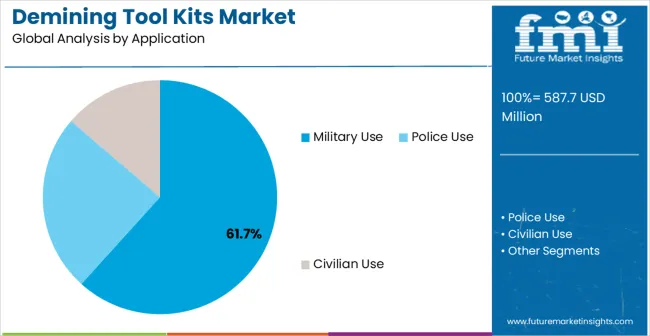
Military use applications dominate the demining tool kits market with approximately 61.7% market share in 2025, reflecting the critical role of mine detection in supporting global military operations and defense preparedness activities. The military segment's market leadership is reinforced by increasing defense budgets, military modernization trends, and rising demand for advanced threat detection solutions in combat and peacekeeping operations worldwide.
The police use segment represents the second-largest application category, capturing 22.8% market share through specialized requirements for explosive ordnance disposal, counter-terrorism operations, and public safety applications. This segment benefits from growing demand for sophisticated detection equipment that meets specific operational requirements, regulatory compliance standards, and safety protocols in civilian security environments.
The civilian use segment accounts for 15.5% market share, serving humanitarian demining organizations, private security companies, and infrastructure protection applications across multiple industry sectors.
Key market dynamics supporting application growth include:
The market is driven by three concrete demand factors tied to security and defense outcomes. First, global security threats and conflict zones create increasing demand for efficient demining solutions, with explosive contamination affecting over 60 countries worldwide, requiring comprehensive clearance infrastructure and advanced detection systems. Second, government defense modernization initiatives and military procurement programs drive adoption of advanced detection technologies, with many countries allocating 15-25% of defense budgets toward security equipment by 2030. Third, technological advancements in detection systems and artificial intelligence enable more reliable and accurate demining solutions that reduce operational risks while improving detection performance and mission success rates.
Market restraints include high procurement costs that can limit adoption among smaller defense forces and humanitarian organizations, particularly in developing regions where funding for advanced security equipment remains constrained. Technical complexity and training requirements pose another significant challenge, as operating sophisticated demining systems requires specialized expertise and comprehensive training programs, potentially causing delays in deployment and increased operational costs. Regulatory and export control restrictions across different countries create additional complexity for manufacturers and end-users, demanding ongoing compliance with varying security standards and international agreements.
Key trends indicate accelerated adoption in Asia-Pacific markets, particularly China and India, where rising security concerns and defense modernization drive comprehensive demining capability development. Technology integration trends toward intelligent detection solutions with AI-powered analysis, automated threat classification, and integrated command systems enable proactive threat mitigation approaches that reduce operational risks and improve mission effectiveness. However, the market thesis could face disruption if alternative threat detection technologies or significant changes in security protocols minimize reliance on traditional demining tool kit systems.
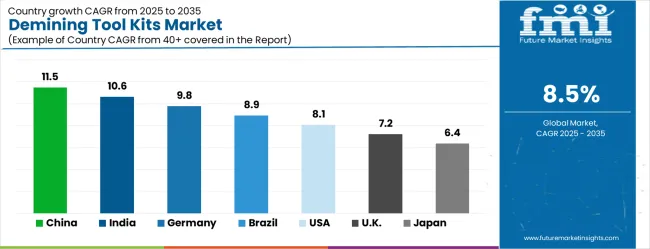
| Country | CAGR (2025-2035) |
|---|---|
| China | 11.5% |
| India | 10.6% |
| Germany | 9.8% |
| Brazil | 8.9% |
| USA | 8.1% |
| UK | 7.2% |
| Japan | 6.4% |
The demining tool kits market is accelerating worldwide, with China taking the lead thanks to comprehensive defense modernization and government-backed security enhancement programs. Close behind, India benefits from expanding military capabilities and border security initiatives, positioning itself as a strategic growth hub in the Asia-Pacific region. Germany shows robust advancement, where integration of advanced detection technologies strengthens its role in the European defense equipment supply chain. Brazil is focusing on security modernization and defense capability development, signaling an ambition to capitalize on growing opportunities in South American security markets. Meanwhile, the USA stands out for its advanced technology adoption in existing military systems, and the UK and Japan continue to record consistent progress in defense modernization. Together, China and India anchor the global expansion story, while the rest build stability and diversity into the market's growth path.
The report covers an in-depth analysis of 40+ countries top-performing countries are highlighted below.
China demonstrates the strongest growth potential in the Demining Tool Kits Market with a CAGR of 11.5% through 2035. The country's leadership position stems from massive defense modernization projects, government-backed security enhancement programs, and stringent safety regulations, driving the adoption of advanced detection systems. Growth is concentrated in major military regions, including Beijing, Shanghai, Guangzhou, and Chengdu, where defense facilities and security organizations are implementing advanced demining solutions for enhanced operational capabilities and personnel safety. Distribution channels through state-owned defense enterprises and government-approved suppliers expand deployment across military installations and security infrastructure projects. The country's military modernization strategy provides policy support for advanced detection system adoption and security technology development.
Key market factors:
In New Delhi, Mumbai, Bangalore, and Chennai, the adoption of advanced demining tool kits is accelerating across military installations and security facilities, driven by border security concerns and government defense modernization initiatives. The market demonstrates strong growth momentum with a CAGR of 10.6% through 2035, linked to comprehensive defense capability development and increasing focus on operational safety solutions. Indian defense forces are implementing advanced detection systems and monitoring platforms to enhance operational effectiveness while meeting growing security demands in border regions and conflict zones. The country's Defense Procurement Policy creates sustained demand for advanced demining solutions, while increasing emphasis on indigenous production drives adoption of domestic and international technology partnerships.
The market in Germany maintains robust growth through focus on NATO interoperability and technology standardization, with a CAGR of 9.8% through 2035. Advanced defense sector in Germany demonstrates sophisticated implementation of demining tool kits, with documented case studies showing 40% operational efficiency improvements in clearance operations through intelligent detection platforms. The country's defense infrastructure in major military centers, including Berlin, Munich, Hamburg, and Frankfurt, showcases integration of advanced detection technologies with existing security systems, leveraging expertise in precision engineering and defense technologies. German defense forces emphasize operational excellence and safety standards, creating demand for high-performance demining solutions that support continuous improvement initiatives and mission optimization requirements.
Key development areas:
Market expansion in Brazil is driven by diverse security demands, including border patrol operations in Amazon regions, urban security initiatives in São Paulo and Rio de Janeiro, and comprehensive defense modernization across multiple military commands. The country demonstrates promising growth potential with a CAGR of 8.9% through 2035, supported by federal defense investment programs and regional security cooperation initiatives. Brazilian military forces face implementation challenges related to budget constraints and technical expertise availability, requiring phased deployment approaches and international cooperation support. However, growing security threats and operational safety requirements create compelling business cases for advanced demining system adoption, particularly in border regions where threat detection has a direct impact on national security.
Market characteristics:
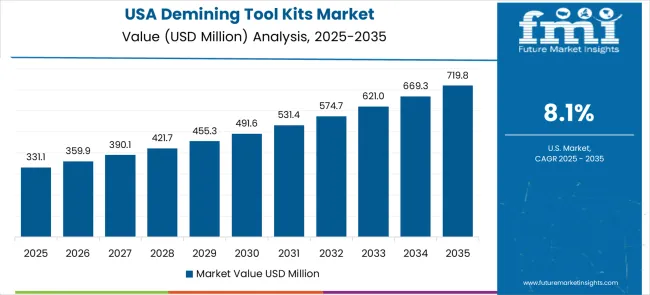
The USA market leads in advanced demining innovation based on integration with intelligent defense systems and smart security technologies for enhanced operational capabilities. The country shows strong potential with a CAGR of 8.1% through 2035, driven by military modernization programs and expansion of advanced detection capabilities across major defense installations in Virginia, California, Texas, and North Carolina. American defense forces are adopting intelligent demining systems for operational efficiency improvement and safety enhancement, particularly in regions with active military operations and advanced training facilities requiring comprehensive threat detection upgrades. Technology deployment channels through established defense contractors and direct procurement relationships expand coverage across military installations and security organizations.
Leading market segments:
In London, Edinburgh, Portsmouth, and other major defense centers, military facilities are implementing advanced demining solutions to enhance operational capabilities and improve personnel safety, with documented case studies showing a 30% reduction in clearance time through the use of intelligent detection systems. The market shows solid growth potential with a CAGR of 7.2% through 2035, linked to ongoing defense modernization programs, NATO capability requirements, and emerging security challenges requiring advanced detection solutions. British defense forces are adopting intelligent detection and monitoring platforms to enhance operational reliability while maintaining safety standards demanded by military regulations and international protocols. The country's established defense infrastructure creates sustained demand for technology upgrade solutions that integrate with existing military systems.
Market development factors:
Japan's Demining Tool Kits Market demonstrates sophisticated implementation focused on precision engineering and operational safety optimization, with documented integration of advanced detection systems, achieving 35% improvement in operational efficiency across defense and security facilities. The country maintains steady growth momentum with a CAGR of 6.4% through 2035, driven by the Self-Defense Forces' emphasis on safety standards and continuous improvement methodologies that align with precision manufacturing principles applied to security operations. Major defense regions, including Tokyo, Osaka, Kyoto, and Fukuoka, showcase advanced deployment of intelligent detection platforms where systems integrate seamlessly with existing defense control systems and comprehensive safety management programs.
Key market characteristics:
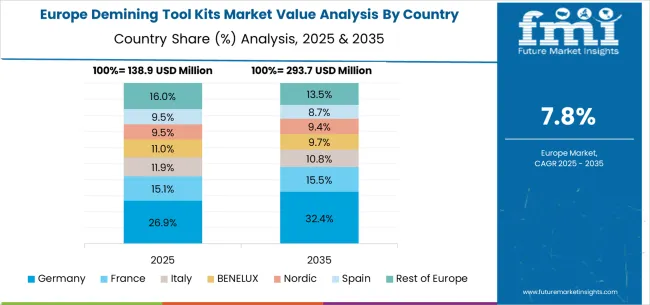
The demining tool kits market in Europe is projected to grow from USD 147.0 million in 2025 to USD 332.2 million by 2035, registering a CAGR of 8.5% over the forecast period. Germany is expected to maintain its leadership position with a 33.4% market share in 2025, declining slightly to 32.8% by 2035, supported by its extensive defense infrastructure and major military installations, including Berlin, Munich, and Hamburg defense facilities.
The United Kingdom follows with a 19.1% share in 2025, projected to reach 19.6% by 2035, driven by comprehensive defense modernization programs in London, Edinburgh, and other strategic areas, which are implementing advanced detection systems. France holds a 16.8% share in 2025, expected to maintain 16.3% by 2035 through ongoing military facility upgrades and defense capability development. Italy commands a 14.2% share, while Spain accounts for 10.7% in 2025. The Rest of Europe region is anticipated to gain momentum, expanding its collective share from 5.8% to 7.0% by 2035, attributed to increasing demining equipment adoption in Nordic countries and emerging Eastern European defense facilities implementing security modernization programs.
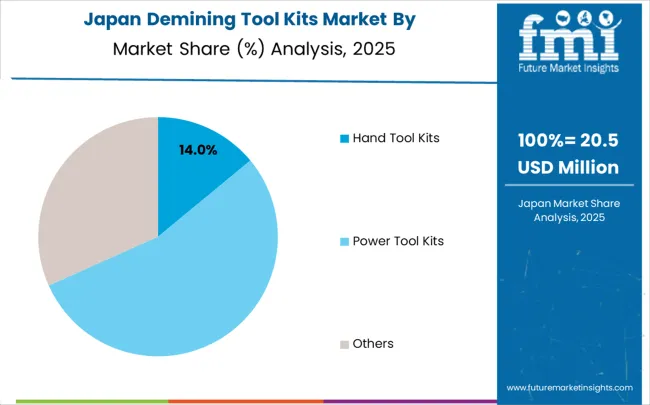
The Japanese Demining Tool Kits Market demonstrates a mature and safety-focused landscape, characterized by sophisticated integration of power tool kits detection systems with existing military command infrastructure across defense facilities, security installations, and specialized training centers. Japan's emphasis on operational excellence and safety standards drives demand for high-reliability demining solutions that support continuous improvement initiatives and statistical safety control requirements in defense operations.
The market benefits from strong partnerships between international technology providers like NIC Instruments, Tactical Electronics, and domestic defense technology leaders, including Mitsubishi Heavy Industries, IHI Corporation, and Kawasaki Heavy Industries, creating comprehensive service ecosystems that prioritize equipment reliability and operator safety programs. Defense centers in Tokyo, Osaka, Kyoto, and other major strategic areas showcase advanced predictive maintenance implementations where demining systems achieve 98% operational readiness through integrated monitoring programs.
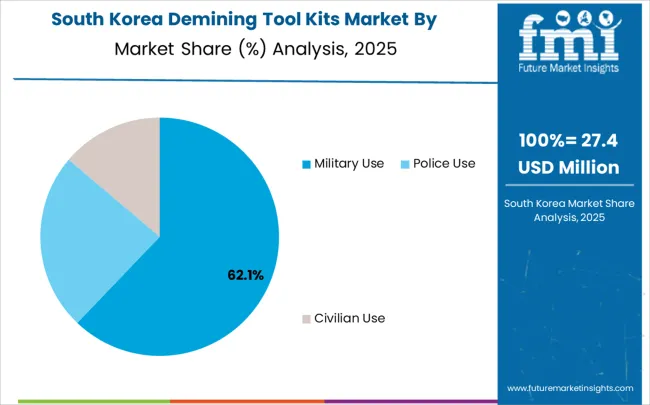
The South Korean Demining Tool Kits Market is characterized by strong international technology provider presence, with companies like NIC Instruments, Tactical Electronics, and Med-Eng maintaining dominant positions through comprehensive system integration and technical services capabilities for military installations and security applications. The market is demonstrating growing emphasis on localized technical support and rapid deployment capabilities, as Korean defense forces increasingly demand customized solutions that integrate with domestic military infrastructure and advanced command systems deployed across the DMZ region and major defense installations.
Local defense contractors and regional system integrators are gaining market share through strategic partnerships with global providers, offering specialized services including technical training programs and certification services for military personnel. The competitive landscape shows increasing collaboration between multinational detection system manufacturers and Korean defense technology specialists, creating hybrid service models that combine international engineering expertise with local security knowledge and defense relationship management.
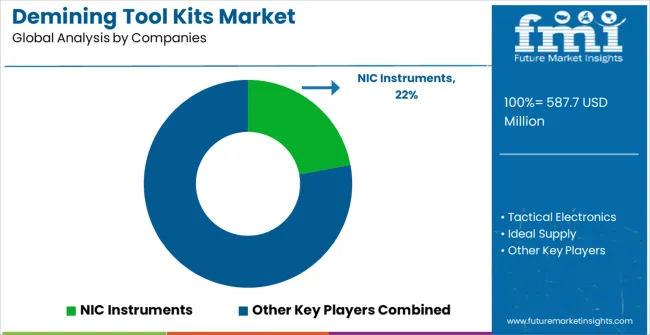
The Demining Tool Kits Market features approximately 15-20 meaningful players with moderate concentration, where the top three companies control roughly 42-48% of global market share through established technology platforms and extensive defense industry relationships. Competition centers on detection accuracy, operational reliability, and safety capabilities rather than price competition alone.
Market leaders include NIC Instruments, Tactical Electronics, and Med-Eng, which maintain competitive advantages through comprehensive detection solution portfolios, global service networks, and deep expertise in the defense and security sector, creating high switching costs for customers. These companies leverage installed equipment relationships and ongoing maintenance contracts to defend market positions while expanding into adjacent security and defense applications.
Challengers encompass Vallon and Ideal Supply, which compete through specialized detection solutions and strong regional presence in key defense markets. Technology specialists, including Blasters Tool & Supply, EPE, and US Testing Equipment, focus on specific detection technologies or vertical applications, offering differentiated capabilities in threat identification, precision detection, and monitoring platforms.
Regional players and emerging technology providers create competitive pressure through cost-effective solutions and rapid deployment capabilities, particularly in high-growth markets including China and India, where local presence provides advantages in customer support and regulatory compliance. Market dynamics favor companies that combine advanced detection technologies with comprehensive service offerings that address the complete equipment lifecycle from deployment through ongoing maintenance and operational support.
Demining tool kits represent critical security equipment that enables military forces, police units, and humanitarian organizations to achieve 70-85% higher detection accuracy than traditional methods while maintaining operational safety during explosive ordnance disposal and mine clearance operations across conflict zones and post-conflict regions. With the market projected to grow from USD 587.7 million in 2025 to USD 1,328.7 million by 2035 at an 8.5% CAGR, these systems offer compelling advantages - advanced threat detection capabilities, integrated AI-powered analysis, and multi-sensor configuration options - making them essential for military use (61.7% market share), police operations (22.8% share), and civilian humanitarian demining seeking alternatives to manual detection methods that compromise personnel safety. Scaling market adoption and technology advancement requires coordinated action across defense policy frameworks, international security standards, specialized equipment manufacturers, end-user organizations, and security investment capital.
How Governments Could Spur Local Production and Adoption?
How Industry Bodies Could Support Market Development?
How OEMs and Technology Players Could Strengthen the Ecosystem?
How Suppliers Could Navigate the Shift?
How Investors and Financial Enablers Could Unlock Value?
| Item | Value |
|---|---|
| Quantitative Units | USD 587.7 million |
| Tool Type | Hand Tool Kits, Power Tool Kits, Others |
| Application | Military Use, Police Use, Civilian Use |
| Regions Covered | Asia Pacific, Europe, North America, Latin America, Middle East & Africa |
| Country Covered | China, India, Germany, Brazil, the USA, the UK, Japan, and 40+ countries |
| Key Companies Profiled | NIC Instruments, Tactical Electronics, Ideal Supply, Med-Eng, Vallon, Blasters Tool & Supply, EPE, US Testing Equipment, ABP Technologies, Security Devices |
| Additional Attributes | Dollar sales by tool type and application categories, regional adoption trends across Asia Pacific, Europe, and North America, competitive landscape with technology providers and system integrators, military facility requirements and specifications, integration with smart defense initiatives and command systems, innovations in detection technology and monitoring systems, and development of specialized applications with accuracy and safety capabilities. |
The global demining tool kits market is estimated to be valued at USD 587.7 million in 2025.
The market size for the demining tool kits market is projected to reach USD 1,328.7 million by 2035.
The demining tool kits market is expected to grow at a 8.5% CAGR between 2025 and 2035.
The key product types in demining tool kits market are hand tool kits, power tool kits and others.
In terms of application, military use segment to command 61.7% share in the demining tool kits market in 2025.






Our Research Products

The "Full Research Suite" delivers actionable market intel, deep dives on markets or technologies, so clients act faster, cut risk, and unlock growth.

The Leaderboard benchmarks and ranks top vendors, classifying them as Established Leaders, Leading Challengers, or Disruptors & Challengers.

Locates where complements amplify value and substitutes erode it, forecasting net impact by horizon

We deliver granular, decision-grade intel: market sizing, 5-year forecasts, pricing, adoption, usage, revenue, and operational KPIs—plus competitor tracking, regulation, and value chains—across 60 countries broadly.

Spot the shifts before they hit your P&L. We track inflection points, adoption curves, pricing moves, and ecosystem plays to show where demand is heading, why it is changing, and what to do next across high-growth markets and disruptive tech

Real-time reads of user behavior. We track shifting priorities, perceptions of today’s and next-gen services, and provider experience, then pace how fast tech moves from trial to adoption, blending buyer, consumer, and channel inputs with social signals (#WhySwitch, #UX).

Partner with our analyst team to build a custom report designed around your business priorities. From analysing market trends to assessing competitors or crafting bespoke datasets, we tailor insights to your needs.
Supplier Intelligence
Discovery & Profiling
Capacity & Footprint
Performance & Risk
Compliance & Governance
Commercial Readiness
Who Supplies Whom
Scorecards & Shortlists
Playbooks & Docs
Category Intelligence
Definition & Scope
Demand & Use Cases
Cost Drivers
Market Structure
Supply Chain Map
Trade & Policy
Operating Norms
Deliverables
Buyer Intelligence
Account Basics
Spend & Scope
Procurement Model
Vendor Requirements
Terms & Policies
Entry Strategy
Pain Points & Triggers
Outputs
Pricing Analysis
Benchmarks
Trends
Should-Cost
Indexation
Landed Cost
Commercial Terms
Deliverables
Brand Analysis
Positioning & Value Prop
Share & Presence
Customer Evidence
Go-to-Market
Digital & Reputation
Compliance & Trust
KPIs & Gaps
Outputs
Full Research Suite comprises of:
Market outlook & trends analysis
Interviews & case studies
Strategic recommendations
Vendor profiles & capabilities analysis
5-year forecasts
8 regions and 60+ country-level data splits
Market segment data splits
12 months of continuous data updates
DELIVERED AS:
PDF EXCEL ONLINE
Tool Holders Market Size and Share Forecast Outlook 2025 to 2035
Tool Box Market Size and Share Forecast Outlook 2025 to 2035
Tool Tethering Market Size and Share Forecast Outlook 2025 to 2035
Tool Steel Market Size and Share Forecast Outlook 2025 to 2035
Tool Presetter Market Trend Analysis Based on Product, Category, End-Use, and Region 2025 to 2035
Understanding Market Share Trends in the Tool Box Industry
Tool Holder Collets Market
Tool Chest Market
Stool Management System Market Analysis - Size, Share, and Forecast Outlook 2025 to 2035
CNC Tool Storage System Market
Brow Tools Market Size and Share Forecast Outlook 2025 to 2035
Hand Tools Market Size and Share Forecast Outlook 2025 to 2035
Key Players in the Hand Tools Market Share Analysis
Power Tools Market Size and Share Forecast Outlook 2025 to 2035
Smart Tools Market Size and Share Forecast Outlook 2025 to 2035
Power Tools Industry Analysis in India - Size, Share, and Forecast Outlook 2025 to 2035
Power Tool Gears Market - Growth & Demand 2025 to 2035
Baking Tools Market Size and Share Forecast Outlook 2025 to 2035
Rotary Tool Market Size and Share Forecast Outlook 2025 to 2035
Edging Tool Market Size and Share Forecast Outlook 2025 to 2035

Thank you!
You will receive an email from our Business Development Manager. Please be sure to check your SPAM/JUNK folder too.
Chat With
MaRIA